Fantasy Books
Women in SF&F Month: Week 2 Schedule & Week in Review
The fourteenth annual Women in SF&F Month continues with four new guest posts this week, starting tomorrow. Thank you so much to last week’s guests for an excellent first week! The new guest posts will be going up on Monday–Thursday of this week, but before announcing the schedule, here are last week’s essays in case you missed any of them. All guest posts from April 2025 can be found here, and last week’s guest posts were: “Let Your Stories Age […]
The post Women in SF&F Month: Week 2 Schedule & Week in Review first appeared on Fantasy Cafe.What Possessed You? — Part III
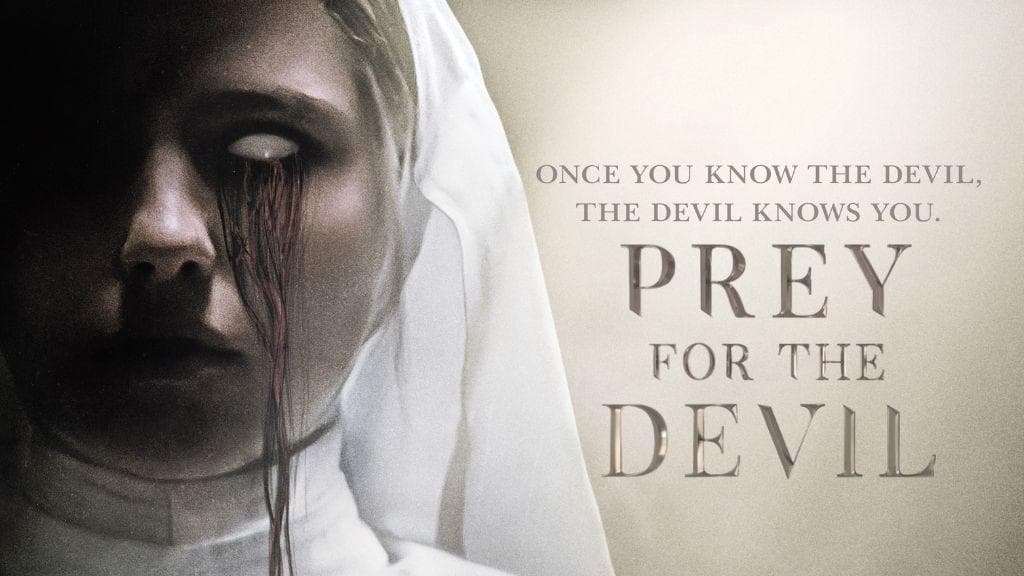 Prey for the Devil (Lionsgate, October 28, 2022)
Prey for the Devil (2022) – Crave (Max)
Prey for the Devil (Lionsgate, October 28, 2022)
Prey for the Devil (2022) – Crave (Max)
Remember how The Hitchhiker’s Guide to the Galaxy‘s entire description of Earth is ‘mostly harmless’? Well, that’s how I’d describe this one. The director, Daniel Stamm, pumped new life into the genre with The Last Exorcism in 2010, but because this film is aiming for that tasty 13+ rating, most of its teeth have been removed.
That said, I liked the idea of the male-dominated world of the church being upended by a nun who has a gift for connecting with possessed patients, and the whole conceit of modern possession running so rampant that the Vatican has set up exorcism training centers is rather fun. Sister Ann is the ‘chosen nun’, stoically played by Jaqueline Byers, and the rest of the cast is great, with Colin Salmon and Ben Cross adding some gravitas to the whole shebang. Sister Ann has quite a few demons of her own to deal with, and it isn’t long before we realize that everything going on in the film is directly for her. There are no surprises here.
There are some genuinely creepy visuals here and there, but Stamm relies too much on jump scares (hampered by the intended rating).
Still, not horrible, but nothing outstanding. Mostly harmless. 6/10
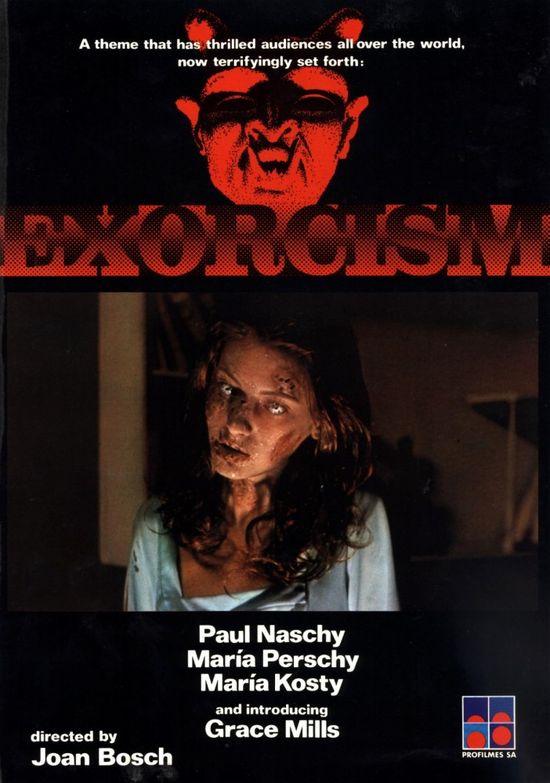
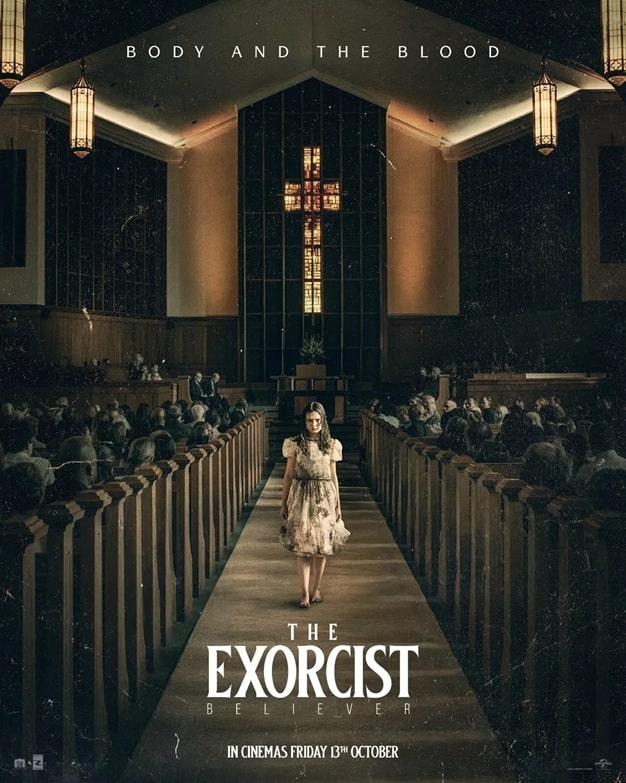
Exorcism (Profilmes, March 10, 1975)
and The Exorcist: Believer (Universal Pictures, October 6, 2023)
The more observant among you will notice that this Spanish production came out two years after The Exorcist, and why not? Priests and pea soup were all the rage back then. Cunningly, Exorcismo was released in Spain *before* The Exorcist, thus making Friedkin and Blatty look like a couple of rip-off artists.
This one stars fan-favourite Paul Naschy as pipe-smoking priest, Father Dunning, a laid-back man of the cloth who has had brushes with Old Nick in the past. Naschy is a dead ringer for John Belushi in this film, and I do enjoy watching him when he is playing a good guy.
Story-wise, some hairy hippies get satanic in a cave, and this leads to a young woman, Leila (played well by Grace Mills), eventually getting possessed by the demonic spirit of her dead dad. It’s a bit of a slow burn to get to the actual exorcism (which takes place in the last 10 mins), as the film takes a giallo turn with a plethora of grisly murders (real head-turners), a pervy chauffeur, African voodoo, and fingers pointed everywhere except at Leila.
Eventually, it’s up to Dunning to confront the possessed woman and do his thing.
There are plenty of obvious Exorcist influences in the film, with a few similar scenes, but this one is fun to watch due to hilarious dubbing (couldn’t find a streaming Spanish version) and copious bosoms.
Trigger warning for dog lovers — there is a good boy called Borg in this film, and his assimilation does not go smoothly. 6/10
The Exorcist: Believer (2023) – PrimeWe’ve reach the much maligned attempt to reboot the ‘Exorverse’ using the team that had some hit and miss success with the new Halloween trilogy.
Having watched it, I can understand the scorn poured upon it.
It’s the age-old possession tale, but this time there’s two! Therein lies the problem. Despite the use of Tubular Bells, and the shoehorning of some old favourites, this has as much to do with the original film as any old bit of guff you might find on Tubi (Exorcist: Vengeance, Exorcist: The Awakening, Exorcist: Butter Sculpture, etc). In lieu of actually focusing on an exorcist, you might think the film would focus on the ‘believer’ of the title, but it’s hard to pin down who that is supposed to be. The film is coded for the principal protagonist to be Tony, played well by Leslie Odom Jr., but he is actually an unbeliever, until it becomes necessary for him to start thinking all the mumbo jumbo is true. This could have been an awesome film if it just focused on him and his lack of belief, and his need to find faith to save his daughter, but the film is stuffed full with other bland characters, diluting the story.
As for the demonic girls themselves, I didn’t like the makeup, but some of the effects were quite interesting.
I was bored until the last 30 mins, and even then the number of useless folks standing around during the actual ‘exorcism’ weakened it to the point where I wasn’t invested in any of the characters.
I felt for young Regan. I couldn’t care less about this bunch. 4/10


Jessabelle (Lionsgate, November 7, 2014)
and Ghostwatch (BBC, October 31, 1992)
Here’s a glimpse into the alchemy that goes into me writing these nonsense reviews. I found a couple of Blumhouse productions; both 90 mins long, one starring Sidney Sweeney (Nocturne) and one starring Sarah Snook (this one — spoiler alert). I watched both trailers to get a sense of which one I wanted to watch, and as intrigued as I was by the Nocturne storyline, it really felt like it was aimed at the Euphoria audience, not a crusty musty old fart like me.
So here we are.
Jessabelle is the story of a young woman who loses her boyfriend, her baby, and the temporary use of her legs in a car crash, and ends up having to live with her estranged father on a vast and soggy tract of land in Louisiana. Jessie (Snook, brilliant) never met her mother, who died from cancer shortly after she was born, but while rummaging around her deceased mom’s bedroom (her new room), she finds a stack of video tapes, addressed to her from her dead mom. Naturally, she plays one, and mom gets downright spooky with a taped tarot reading — from that point on it’s Haitian shenanigans ahoy as a potentially malevolent spirit starts getting all up in her wheelchair. It’s a solidly made film with excellent performances, and my only gripe is with the denouement, which is spewed out like Sherlock Holmes after a line of Afghan fairy dust.
Still, it’s a decent effort, and lands on the ‘good’ side of the Blumhouse production legacy. 7/10
Ghostwatch (1992) – PrimeHere’s the weird thing. I have no recollection of the hysteria caused by this mockumentary, and in fact I’ve never seen it before (although I was aware of it). I wonder if it coincided with a Halloween party I threw with my then landlord in Wimbledon. Anyhoo, folks seem to like it a lot, so I had to take a look.
I suspect non-Brits get more of a kick out of this film than us limeys who grew up watching these real-life presenters. Parky was an inspired choice to host it, as he was already a well-respected interviewer, and his Yorkshireness would not put up with any bull.
Sarah Greene was the first crush of many youngsters during her time on Blue Peter, and she is definitely the MVP in this. Mike Smith was a bit of a potato, and Craig Charles was hilarious — he elicited the biggest laugh out of me when he manhandled the trick-or-treater at the end.
The rest of the cast was fair to middling, but they can be forgiven for any stilted deliveries due to the fact that this was, of course, basically a television play.
I did like the story, and was surprised how dark it really got toward the end. Also, the occasional flashes of ‘Pipes’ reflected in doors and mirrors was excellent, and really added to the atmosphere. A fun watch. 8/10

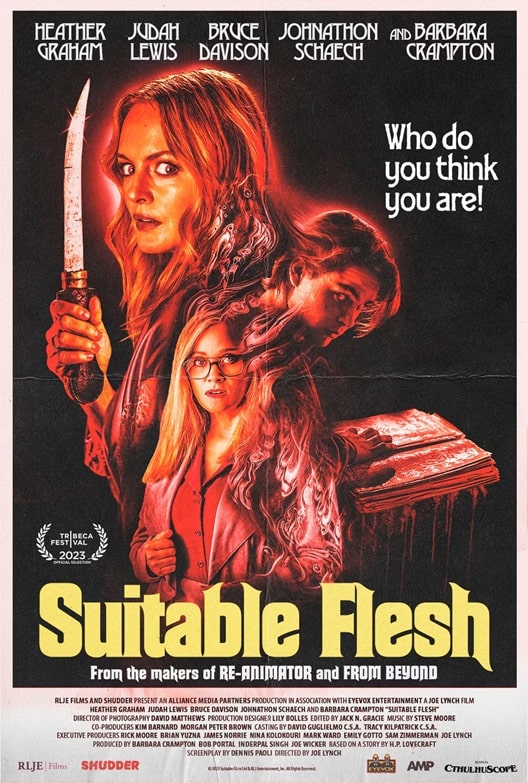
Verónica (Sony Pictures International, August 25, 2017)
and Suitable Flesh (RLJE Films/Shudder, October 27, 2023)
My penultimate film is Verónica, a Spanish film directed by Paco Plaza (REC and REC 2, Sister Death) loosely based on a true event in which a girl died after after performing a séance at a school in Madrid with her friends. Plaza keeps the film grounded enough for the truth to be ambiguous — did the spooky stuff happen, or was it all in her head?
Either way, he has constructed an effectively chilling story, beautifully shot and wonderfully acted. The lead, Sandra Escacena, is excellent as Verónica, and her young siblings are portrayed by some of the best child actors I’ve ever seen. Truly believable, and cute as a button, which makes the ongoing threat to them even more distressing. After the séance, Verónica begins to suspect that an evil entity has possessed the house (or possibly herself), and we are witness to her unravelling over a nightmare-riddled three days. The mom is mostly absent due to wok, so 14-yr-old Verónica must assume all of her duties, plus survive middle school. It’s an awful situation, and your heart bleeds for their family.
The supernatural elements were creepy and unsettling, and only relied on jump scares once or twice — the rest of the horror comes from the pervasive sense of doom. Great stuff. 8/10
Suitable Flesh (2023) – Prime/AMC+I showed great restraint in waiting to watch this one, as I really like Joe Lynch as a director (Wrong Turn: Dead End, Mayhem), Dennis Paoli (Re-Animator, Dagon, From Beyond) returned to write it, and it stars Barbara Crampton, who seems to be eternal.
Bottom line — I loved it. I thought Lynch really nailed the 80s Lovecraft adaptation aesthetic, down to the score, the dutch-angles, the cheesy one-liners and the excessive gore. Heather Graham was perfect as Dr. Beth Derby, a psychiatrist who becomes entangled in the life of a disturbed young man, Asa Waite, played well by Judah Lewis. It isn’t long before she is thoroughly on the road to madness (is it madness though? Aha!), and much murder and body-swapping ensues.
Lynch peppers the film with stunning set-pieces (my favourite being the rear camera shots on the car), and enough erotica to make the puritanical Lovecraft quite queasy (H.P. sauce, if you will). The Old Ones among you will notice some familiar names and locations (Miskatonic among them), and it will soon be apparent this is an adaptation of a favourite HPL story, ‘The Thing on the Doorstep.’
Some relocation and gender-swapping has taken place in the retelling, and this is perfectly in line with the film’s theme. In fact, Lynch and Paoli have also managed to sneak some other pertinent themes in, not least of which is the importance of female body autonomy.
A glorious way to finish this watch-a-thon. 9/10
Previous Murkey Movie surveys from Neil Baker include:
What Possessed You? — Part I
What Possessed You? — Part II
Fan of the Cave Bear
There, Wolves
What a Croc
Prehistrionics
Jumping the Shark
Alien Overlords
Biggus Footus
I Like Big Bugs and I Cannot Lie
The Weird, Weird West
Warrior Women Watch-a-thon
Neil Baker’s last article for us was Part II of What Possessed You? Neil spends his days watching dodgy movies, most of them terrible, in the hope that you might be inspired to watch them too. He is often asked why he doesn’t watch ‘proper’ films, and he honestly doesn’t have a good answer. He is an author, illustrator, teacher, and sculptor of turtle exhibits. (AprilMoonBooks.com).
6 Banned Books by Women You Must Own and Read
In the world of literature, banned books by women hold a unique and powerful place.…
The post 6 Banned Books by Women You Must Own and Read appeared first on LitStack.
Marvel Studios’ The Infinity Saga – ANT-MAN: THE ART OF THE MOVIE by Jacob Johnston
Tor Doubles: #0: Keith Laumer’s The Other Sky and The House in November
 The Other Sky cover by Thomas Kidd
The Other Sky cover by Thomas KiddThe House in November cover by Mike Embden
Between October and December of 1969, Keith Laumer’s novella The Seeds of Gonyl were published as a serial in the magazine Worlds of If. The story was published the following year in a hardcover by G.P. Putnam & Sons under the title The House in November, and in 1971 as a paperback by Berkley Medallion.
In 1981, Tor reprinted the novel as part of its “Jim Baen Presents” series, but, apparently deeming the novel too short, it paired it with Laumer’s story “The Further Sky,” which had originally be published in the December 1964 issue of Amazing Stories. That story had also undergone a name change and appeared as “The Other Sky” in various reprints, including its appearance with The House in November.
When Tor Books reprinted the volume in 1985, they included a shield on the cover identifying the book as a “Tor Double.” This book may possibly have been created as a dry run or proof of concept for the eventual Tor Double line. The cover for The Other Sky was provided by Thomas Kidd and the cover for The House in November was provided by Mike Embden, although their credits are reversed on the copyright pages.
“The Other Sky” opens with Vallant having a run-in with the Niss, an alien race that is working in collaboration with humans, although immediately after, he finds an old man in his apartment. The stranger not only claims to have been one of Vallant’s comrades several years earlier (although Vallant has no memory of the man or the situation he describes), but also warns Vallant against the Niss before disappearing through a secret panel in Vallant’s apartment.
When Vallant tries to follow the old man, who discovers he has been killed by the Niss, but he also finds himself taking responsibility for Jimper, an intelligent creature. Jimper confirms what the old man had told Vallant about the Niss, but takes it a step further, claiming to be an ambassador from the King of Galliale to the Humans to form an alliance against the Niss.
Vallant and Jimper flee and find themselves among Jimper’s people on Pluto, although Jimper is not greeted in the manner in which he expects. Although neither Vallant or Jimper understand what is happening, either with the humans, the Niss, or the Gaillialans, Laumer has left enough clues that the reader has a pretty good idea what must happen for all of the pieces to come together. The addition of a portal to another world only helps seal the deal.
However, the quick sequential scenes don’t allow Laumer to fully build the characters or their situations, giving “The Other Sky” the feeling of an outline for a longer work, which means the story is ultimately disappointing and unsuccessful.
For a modern reader, Jimper’s manner of speaking in the third person has the same cadences as J.K. Rowling’s house-elf, Dobby, which bring images to mind as the novel progresses which may not be fair or accurate to Laumer’s portrayal.
 Amazing Stories cover by Robert Adragna
Amazing Stories cover by Robert AdragnaWorlds of If cover by Jack Gaughan
The House in November follows Jeff Mallory through a post-war Nebraskan landscape, although the nature of the war is ill defined. At the beginning of the novel, Mallory is awaking from a fugue state. Although he has memories of working in the Miller Building, his wife, Gillian, insists they both work in the Star Tower. In addition, Gillian has no recollection of their oldest child, Lori, or a house in the country where they have spent their time. Leaving he house, he discovers that everyone in town seems to live in the same alternative world Gillian exists in and he flees into the countryside.
As he travels, Jeff discovers that there has been some kind of invasion which has depopulated most of the United States. He comes across small bands of refugees, most of whom are not hospitable t a stranger, although along his travels he connects with Sally, one of his daughter Lori’s friends, and they travel together, eventually finding an ersatz army but together by Colonel Strang. Lori appears to be supporting Strang’s army, and Jeff finds himself impressed into service.
Strang is convinced that the Chinese have invaded the United States and set up their base in Beatrice, the town where Jeff has been living. Nothing Jeff can say will make Strang believe that there are Americans still living in Beatrice and there are no Chinese. Eventually going AWOL, Jeff finds others who are convinced the invasion is from Satanic minions. Jeff is positive the invasion is by aliens, based on what he saw in Beatrice before he left. Although Laumer could have played up Jeff’s paranoia, making the reader question Jeff’s conclusions, The House in November is written in a way that makes the reader side with Jeff against any other theories, all of them as bereft of evidence as any of the others.
Eventually, Jeff does learn what is going on and the reader discovers that for all his normalcy, Jeff is not a normal person. He is, in many ways, the Chosen One, which may ultimately allow him to break through the haze that has settled on so many people and show them the truth of the situation, and possibly even find a solution.
Much of The House in November is episodic in nature and Laumer doesn’t spend too much time exploring any of the episodes. He gets out of Beatrice as quickly as possible at the beginning of the book. The scene in which he finds Sally living with a few survivors is over almost as soon as it starts. His encounter with Colonel Strang’s army, including Lori, exists to give him an idea of how different people’s ideas are, but he quickly leaves them behind and manages to avoid capture by Strang’s forces looking for him. Other scenes are similarly brief, which gives the story a rushed and unfinished feel, as if any of these sequences, or characters, could and should have been fleshed out more than they were.
The novella only finds its pacing when Jeff arrives at the titular house and comes into contact with Gonyl, who may be able to provide him with the answers he seeks. Having set up the world, Laumer is now able to explain to Jeff and to the reader what is happening and why Jeff was able to come out of the stupor in which he found himself.
Both stories in this volume suffer from pacing issue, both of them almost feeling as if they are outlines for more detailed novels. Laumer has elected to include several short scenes which hint at the larger concern, failing to fully flesh them out and never quite connecting with the readers, who never really had a chance to immerse themselves in the action. Both stories are tales of invasion by alien forces which are not fully understood by the people who have fallen under the alien’s control.
 Steven H Silver is a twenty-time Hugo Award nominee and was the publisher of the Hugo-nominated fanzine Argentus as well as the editor and publisher of ISFiC Press for eight years. He has also edited books for DAW, NESFA Press, and ZNB. His most recent anthology is Alternate Peace and his novel After Hastings was published in 2020. Steven has chaired the first Midwest Construction, Windycon three times, and the SFWA Nebula Conference numerous times. He was programming chair for Chicon 2000 and Vice Chair of Chicon 7.
Steven H Silver is a twenty-time Hugo Award nominee and was the publisher of the Hugo-nominated fanzine Argentus as well as the editor and publisher of ISFiC Press for eight years. He has also edited books for DAW, NESFA Press, and ZNB. His most recent anthology is Alternate Peace and his novel After Hastings was published in 2020. Steven has chaired the first Midwest Construction, Windycon three times, and the SFWA Nebula Conference numerous times. He was programming chair for Chicon 2000 and Vice Chair of Chicon 7.
Exile's Hunter - Book Review by Voodoo Bride
 Exile's Hunter (Alien Mates: Planet Exile #1)by Kate Rudolph
Exile's Hunter (Alien Mates: Planet Exile #1)by Kate RudolphWhat is it about:Kenzie will do anything to save her sister... even if it means teaming up with a dangerous alien who makes her heart pound.
Kenzie has crossed the galaxy in search of her abducted sister and she's finally landed on Guerran. It's a planet full of criminals and she can trust no one, especially not the terrifyingly hot alien named Mad.
He's as much a criminal as anyone on Guerran. And he's her only hope. But she isn't sure whether she should kiss him or stab him when his presence makes her heat up with desire.
Mad can't leave the exile planet. Once Kenzie finds Carise, the sisters will be long gone. There's no future between her and the hunky alien, no matter how quickly he steals her heart.
How can Kenzie walk away when fate has put her in the path of her mate?
What did Voodoo Bride think of it:I will confess I fell for the cover of this book.But after reading some SciFi Romance stories recently, I was in the mood for more and this one didn't just have a shiny purple cover with an interesting hero on it, it sounded good as well.
And I had a great time with it.
I really liked Mad. Being exiled and having to survive on a prison planet has made him hard, but still good at heart. I rooted for him to get everything he longed for.
Kenzie was mostly a great character as well. She was the typical big sister though - and it worked better than in most books, because after all her younger sister was abducted - and I really don't like the 'older sibling knows what's best for the younger one' trope/characteristic.
I very much enjoyed the story and the romance between Mad and Kenzie. The steamy scenes were delicious and their growing relationship had me hoping the two of them could work things out and save the day.
There was one character who I suspect has her own book in another series by Rudolph, and there is also another book in this series that will be about two characters introduced in this one. I'll most definitely will get hold of the latter, and I will investigate other books by Rudolph.
Why should you read it:It has a strong hunky alien!
Audiobook Review: The Fourth Consort by Edward Ashton
I received a review copy from the publisher. This does not affect the contents of my review and all opinions are my own.
 The Fourth Consort by Edward Ashton
The Fourth Consort by Edward Ashton
Mogsy’s Rating (Overall): 3.5 of 5 stars
Genre: Science Fiction
Series: Stand Alone/Book 1
Publisher: Macmillan Audio (February 25, 2025)
Length: 8 hrs and 25 mins
Narrator: Barrie Kreinik
I became a fan of Edward Ashton after his action sci-fi adventure Mickey7 impressed me with its sense of humor, even when dealing with a subject like existential dread. Naturally, when I heard about The Fourth Consort, I was curious to see what it’s all about.
The story follows Dalton Greaves, who has been living adrift ever since the death of his father. All this changes one night in a bar, when, after his girlfriend dumps him, he is approached by Neera, a representative of the Unity who offers him a job. It’s an opportunity for Dalton to forget his aimless life on Earth and become a part of something bigger, joining an organization with a mission for peacekeeping and cooperation to unite all sentient beings in the galaxy. Since there’s nothing left tying him to his old life and plenty to gain from the new gig, Dalton agrees.
However, the truth is much less glamorous. The Unity turns out to be not so noble after all, once Dalton gets a glimpse behind the curtains and sees how things really are. The galaxy’s true benefactors are in fact the Assembly, bitter rivals of the Unity who view Dalton and Neera with suspicion. After a disastrous encounter in orbit leaves the two humans stranded on a newly discovered world, Dalton suddenly finds himself separated from Neera’s protection and thrust into the clutches of the planet’s native inhabitants, whose ruling queen claims him as her consort—her fourth one, as it turns out. Meanwhile, stuck at court with him is also an alien named Breaker, a stickman who fights on behalf of the Assembly. Caught reluctantly in the politics of his role where enemies can strike from any direction, Dalton must figure out how to navigate this strange new world and survive Neera’s scheming even as she tries to rescue him.
At its core, The Fourth Consort is a quirky sci-fi novel that doesn’t take itself too seriously—definitely similar in tone to the Mickey7 series, which is good news if that’s what you were looking for. Ashton’s writing style is as sharp and efficient as ever, keeping the story moving along at a fast clip. The humor is also on point with plenty of witty banter and absurd moments, especially when alien cultures collide, often leading to Dalton trading barbs with his spicy translator AI.
But for its quick pacing and super lean prose which doesn’t bog itself down with unnecessary exposition, the story does sometimes feel a little too breezy for its own good. The world-building, for instance, is intriguing but on the lighter side, leaving many questions and difficulties envisioning the creatures and worlds being described. I never got a strong sense of the alien cultures and what makes them genuinely unique, and similarly, the political intrigue felt tacked on rather than fully integrated. Likewise, character development is another area that felt a little sparse, and although Dalton himself is a solid protagonist, he lacked agency and seemed carried along by events, robbing his personality of opportunities to shine.
This made the overall story arc feel kind of shallow and undercooked. While the plot featured conflicts aplenty, there was hardly any tension at all as I was never made to believe our protagonist was ever really in trouble. If anything, Breaker, the Assembly shock trooper, felt more developed even though we mainly got to know him through conversations filtered across broken translations. Sure, the occasional flashback to Dalton’s past helped, but many of them felt like flavor text and completely unnecessary, and I’m not sure that these little snippets featuring his pre-Unity days were quite worth the distraction.
That said, hopefully I didn’t come off as too negative, as The Fourth Consort actually turned out to be a very enjoyable and fun read, especially the audio book version whose narrator Barrie Kreinik gave a lively performance. The pacing was tight, the humor sharp, and I loved the clever dialogue. However, while the book is entertaining in the moment, I don’t think it will leave a lasting impression. If the author decides to continue Dalton’s tale, I’d be interested to see where he ends up taking things, but as it stands, this one gets a solid 3.5 stars.
![]()
![]()
A Lot of Camelot: The Bright Sword by Lev Grossman
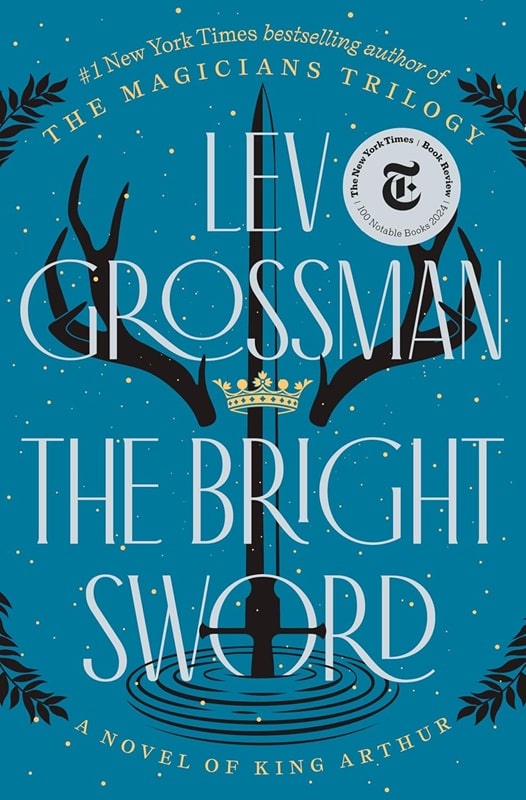

The Bright Sword (Viking, July 16, 2024)
With no disrespect to J.R.R Tolkien, the King Arthur legend is arguably the inspiration of much post World War II medieval-based fantasy. You’ve got your out-of-nowhere claimant to the throne, a magic sword, court intrigue, some side stories, romance, sorcery, betrayal but yet a kind of redemption. All the key ingredients.
Sure, Game of Thrones was based on the very real English Wars of the Roses, particularly the also very real violence and death of key personages. But let’s look at the long literary tradition of Arthurian stories: sourced from Welsh mythology and grafted into 12th century British histories more based on fancy than fact, eventually becoming the Chrétien de Troyes romances and subsequently Thomas Malory’s Le Morte d’Arthur. From multiple sources and variations we wind our way through Tennyson’s The Lady of Shallot which in turn inspires various associated fictions, not the least of which includes Mark Twain’s A Connecticut Yankee in King Arthur’s Court.
Fast forward to T.H. White’s The Once and Future King and its adaption by Lerner and Loewe musical Camelot (“If ever I would leave you, it wouldn’t be in summer…”). With the assassination of John F. Kennedy, Camelot became a metaphor for “a shining moment” intervened by fate to extinguish, that nonetheless, like the Christ-like resurrection grafted on to the Arthurian mythos, may inspire future generations. (Only a cynic would make comparisons between Guenevere’s infidelity and Kennedy’s.)
So while the Arthurian narrative is heavily played out by the middle of the 20th century, there’s still more to come. An extermely short list includes Thomas Berger’s Arthur Rex, The Warlord Chronicles by Bernard Cornwall and, of course, the Monty Python and the Holy Grail movie (inspired in part by the academically disputed contention of Python member Terry Jones that Chaucer’s The Knight’s Tale was actually a satire of a mythical chivalric code and courtly love rather than a celebration of it).
One of my particular favorites is Lavie Tidhar’s By Force Alone, a political satire in which Arthur is a gang lord, Lancelot a martial arts practitioner, no one is noble of heart, and Arthur’s death is instead of a Christ-like hope for resurrection a comment on the existential insignificance and intransigence of power.

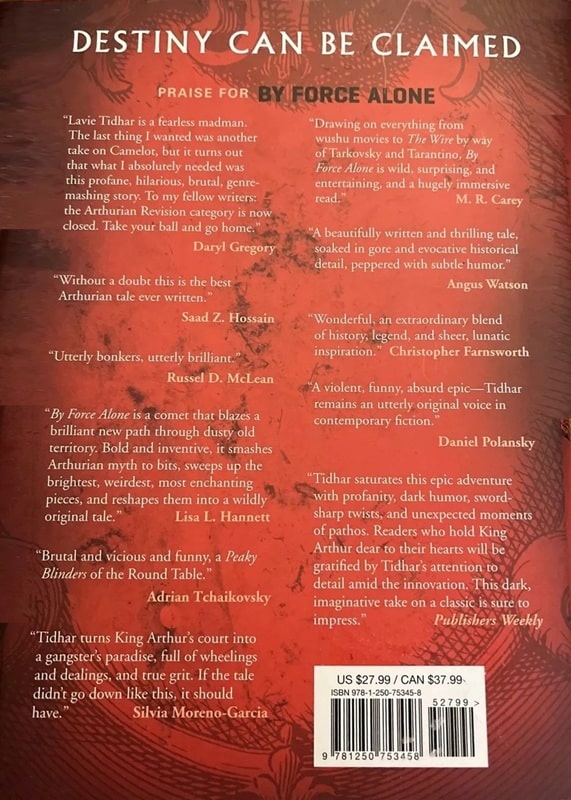
By Force Alone by Lavie Tidhar (Tor Books, August 11, 2020)
Particularly noteworthy is that Guinevere is no mere cardboard supporting character, but more independent woman with agency of her own. This more modern depiction of women in the Arthurian legend is especially associated with Marion Bradley Zimmer’s The Mists of Avalon retelling from the perspective of Morgaine, who rather than as a one-dimensional evil sorceress is depicted as a sympathetic complex woman during the transition in Britain from paganism to Christianity. Published in the early 1980s and the rise of feminist voices not only in fantasy literature (though, ironically, some critics detect anti-feminist themes in Zimmer’s work, and allegations of sexual abuse by her daughter don’t help) but the larger zeitgeist, more female-centric retellings of the Arthurian legend followed, such as, most recently, Nicola Griffith’ s Spear and Half Sick of Shadows by Laura Sebastian, as just two examples.
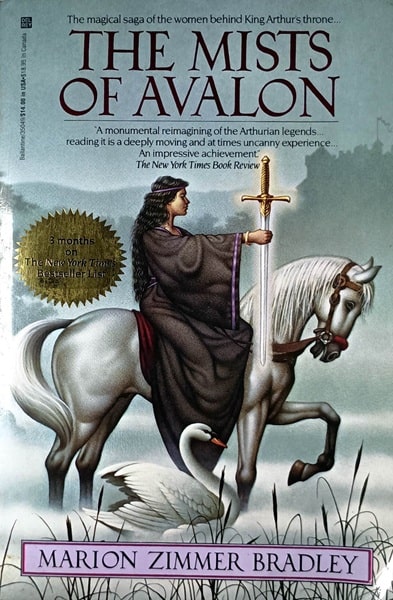
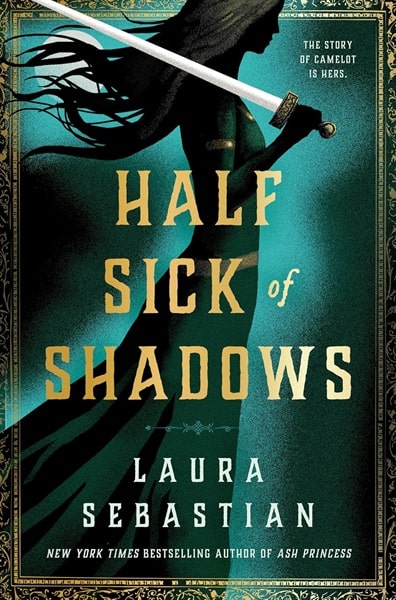
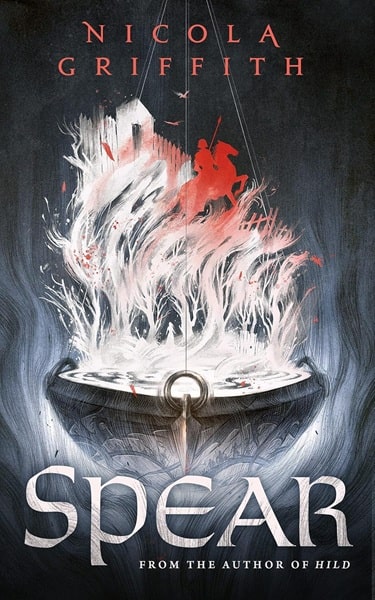
The Mists of Avalon by Marion Zimmer Bradley (Del Rey, May 1984), Half Sick of Shadows
by Laura Sebastian (Ace Books, July 6, 2021), and Spear by Nicola Griffith (Tor, April 9,
2022). Covers by Braldt Bralds, uncredited, and Rovina Cai
So the legend of Arthur has been retold down through the centuries and even with multiple variations and exegesis, we still have the basic uber narrative of a brief realization of an ideal doomed by historical, religious, and insidious forces to failure. Is there still room for yet another appraisal that just doesn’t rehash the same old same old?
Apparently so. To the extent of 670 pages in Lev Grossman’s The Bright Sword. That’s a lot of Camelot.
I confess that if I hadn’t previously read The Magician’s Trilogy (which perhaps explains why the cover prominently features reference to it, leading some online cataloguers to incorrectly attribute The Bright Sword as part of that series), I might not have picked this up (as a nearly 700 page book makes it hard to do).
Indeed, Grossman himself notes:
I spent most of my life blissfully uninterested in writing anything at all about King Arthur…His story has already been told thousands of time, from every possible point of view… Arthur is also, as it happens, white, middle-aged, heterosexual, and cis-gendered, a point of view that is hardly lacking in contemporary literature.
But by focusing on how the peripheral characters of the Round Table come to grips with a new era following Arthur’s death (or at least his transport to Avalon following his mortal wounding), Grossman comes up with a new and fresh angle.
Collum is a gifted knight wannabe (the one character that Grossman makes up) escaping an abusive home whose first kill (and pivotal plot point) is a recalcitrant knight with successful suicidal tendencies. This occurs as Collum is on his way to fight for a seat at (unbeknownst to him) what’s left of the Round Table band (which isn’t much) following King Arthur’s mortal wounding by his bastard (and product of incest with his sister Morgause, something the juvenile versions of Arthur kind of gloss over) son Mordred at the Battle of Camlaan. Featured surviving bit players include Sir Bedivere, whose devotion to Arthur hides unfulfilled carnal desire, Sir Palomides, a Middle Eastern pagan convert and hunter of the Questing Beast whose particular unrequited love is Iseult of Wagner’s Tristan and Isolde fame, Tristan’s close friend Sir Dinadian, and Sir Dagonet, Camelot’s court jester who is better at joking than jousting.
Don’t worry, Lancelot and Guinevere and the rest of the main cast make cameo appearances, but not as you might expect them. The narrative focuses primarily on the minor characters as they attempt to restore (as you might expect, not successfully) the glory of Arthur’s reign and intentions, with sidesteps into their backstories. As for Arthur himself, well, we already know it doesn’t end well. But it still inspires. As Grossman notes:
King Arthur’s life can only ever end one way, his doom is always waiting for him…of course even after his death Arthur himself is never quite gone. He’s been with us for 1,400 years and counting now and shows no signs of going away. Like Godot he’s always coming, but always tomorrow, never today. He waits, asleep in Avalon, the Fortunate Isle. or under Mount Etna in Sicily, as some other stories have it, dreaming eternally of his homecoming. We dream of it too.
David Soyka is one of the founding bloggers at Black Gate. He’s written over 200 articles for us since 2008. His most recent was a review of State of Paradise by Laura Van Den Berg.
Women in SF&F Month: One Level Down Giveaway
Today I have two trade paperback copies of a new science fiction novella to give away to two US residents, courtesy of Tachyon Publications! Described as “a taut, ultimately hopeful story that deftly explores identity and autonomy,” Mary G. Thompson’s newest book, One Level Down, was just released on April 1. More information on the book, author, and how to enter is below. Enter the One Level Down Giveaway About ONE LEVEL DOWN: Trapped in a child’s body, a resourceful […]
The post Women in SF&F Month: One Level Down Giveaway first appeared on Fantasy Cafe.Spotlight on “Mapping the Interior” by Stephen Graham Jones
Mapping the Interior is a spine-tingling journey through a young boy’s haunted home. About Mapping…
The post Spotlight on “Mapping the Interior” by Stephen Graham Jones appeared first on LitStack.
On McPig's Wishlist - Snake-eater
 Snake-eaterby T. Kingfisher
Snake-eaterby T. KingfisherIn an isolated desert town, a young woman seeking a fresh start is confronted by ancient gods, malevolent supernatural forces, and eccentric neighbours. A witty horror-tinged fantasy, perfect for fans of Silvia Moreno-Garcia, Chuck Tingle, and Rachel Harrison.
When Selena travels to the remote desert town of Quartz Creek in search of her estranged Aunt Amelia, she is desperate and short of options. Fleeing an unhappy marriage, she has exactly twenty-seven dollars to her name, and her only friend in the world is her dog, Copper.
On arrival, Selena learns Amelia is dead. But the inhabitants of Quartz Creek are only too happy to have a new resident. Out of money and ideas, Selena sees no harm staying in her aunt's lovely house for a few weeks, tending to her garden and enjoying the strange, desolate beauty of the desert. The people are odd, but friendly, and eager to help Selena settle into her new home.
But Quartz Creek's inhabitants share their town with others, old gods and spirits whose claim to the land long predates their human neighbours. Selena finds herself pursued by disturbing apparitions, visitations that come in the night and seem to want something from her.
Aunt Amelia owed a debt. Now her god has come to collect.
Expected publication November 11, 2025
Women in SF&F Month: M. H. Ayinde
Today’s Women in SF&F Month guest is M. H. Ayinde! Her science fiction, fantasy, and horror short stories include “The Techwork Horse” (featured on the Locus Recommended Reading List), “Blind Eye” (selected for the BSFA Award longlist), “The Walls of Benin City” (selected for the BSFA Award longlist and The Best of World SF: Volume 3), and “Worst Place Ever – Avoid!” (winner of the March 2021 Apex Magazine Microfiction Contest). A Song of Legends Lost, her debut novel and […]
The post Women in SF&F Month: M. H. Ayinde first appeared on Fantasy Cafe.To Save Your Sanity, Take Steven Leacock’s Nonsense Novels and Call Me in the Morning (or, Why Are Canadians Funny?)
You need a good laugh right now. How do I know this? I know this because I need a good laugh right now. Everyone I know needs a good laugh right now, so it stands to reason that you need one too, doesn’t it?
So… where to go for that much-needed laugh? Well, there are standup specials on Netflix and the other streamers, you’ve got SNL, there are the many late-night topical jokemeisters — all the usual suspects. Now if that stuff really makes you feel better, more power to you; there’s so much of it available these days, you’re in the enviable position of being a kid locked in a candy factory. For me, though, none of those folks can talk for two minutes without referring to you-know-who who lives you-know-where and is up to you-know-what, and I’m sorry, but all that usually ends up making me feel worse.
To maintain minimal sanity, sometimes what I need most is something that will take me to a place that Thomas Hardy (who briefly hosted the Tonight Show after Conan O’Brien was fired) called “far from the madding crowd.” I don’t want something that’s out to earn my approval because it’s correct; I want something that’s out to make me laugh because it’s funny.
Fortunately, several years ago, I found a fabulous device that accomplishes just that. It’s called… are you ready for this? It’s called a book. And that’s not the half of it. It was written by a fellow named Stephen Leacock, and this guy was… I can’t believe I’m saying this… he was… a Canadian.
How can a Canadian be funny? The answer to that is above my pay grade (could it have anything to do with the fact that for the past two hundred and fifty years, Canadians have had a south-facing front row seat at the world’s most outrageous farce… nah, that can’t be it), but I do know that Canadians are funny, and I’ve known it ever since the mid 70’s when I fell head over heels in love with SCTV, which I believe to be the greatest sketch comedy show of all time, despite the fact that it was mostly a product of Canada. I stopped watching SNL over forty years ago, but I still regularly pop in an SCTV DVD; I just watched one last night, as a matter of fact. In any case, even if Bobby Bitman and Lola Heatherton and Johnny LaRue and Bill Needle and Gerry Todd had never existed, you could still win your Canadian Comic Case by offering Stephen Leacock as exhibit A, and if you won’t take my word for it, the man was Groucho Marx’s favorite comic writer — of any nationality. Think about that — he made Groucho Marx laugh.
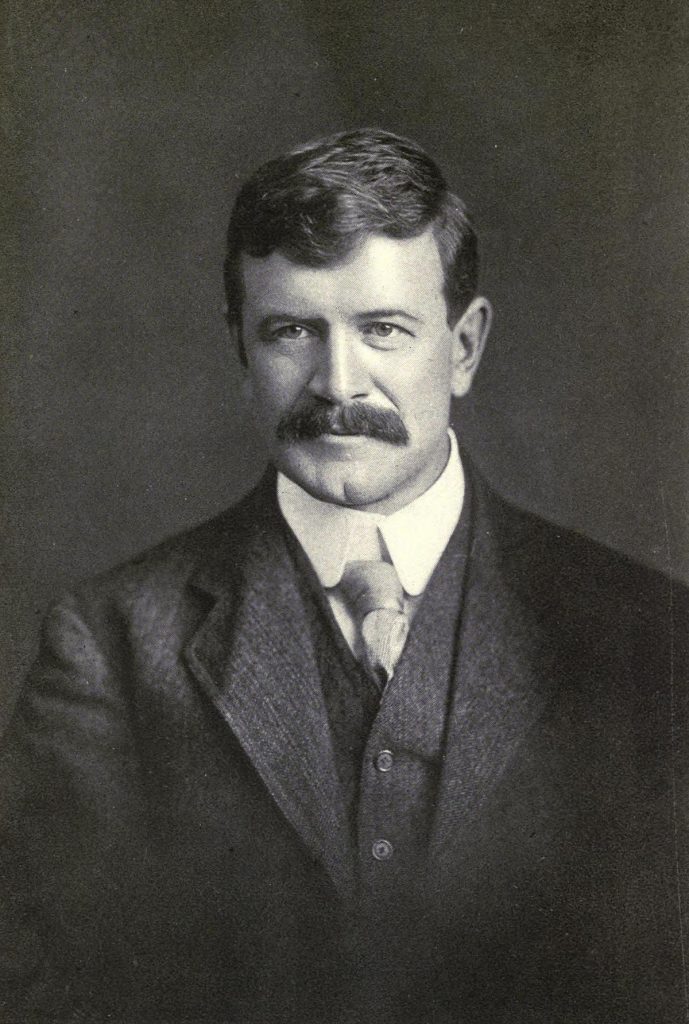 That’s funny – he looks funny, but he doesn’t look Canadian
That’s funny – he looks funny, but he doesn’t look Canadian
And yes, he was really a Canadian; though born in England in 1869, Stephen Leacock lived in Canada from the age of six. He was a resident of Montreal and taught economics at several Canadian universities.
But what you want to know right now is the name of his book, right? The one I’m talking about (he wrote many more) is called Nonsense Novels, and it was first published in 1911. It’s currently available in a few different paperback editions, though the one I have, a nice hardcover from New York Review Books, is unfortunately out of print. I say unfortunately because hardcovers hold up better than paperbacks, and in the time that I’ve had my copy, it’s gotten a lot of hard use. I imagine the same will be true of whatever copy you get your hands on.
Nonsense Novels consists of ten short chapters (each one anywhere from ten to fifteen pages; my NYRB edition is only 159 pages long), and each chapter is a self-contained parody of a nineteenth or early twentieth century popular fiction genre, most of which have been deposited on the ash-heap of publishing, though a few are still alive and kicking. That doesn’t matter, though — the customary devices, the stock characters and situations, the tropes and cliches of each genre have long since been engraved on our cultural memory (through movies, if nothing else) and you’ll have no problem getting the jokes.
So, what we have here are spot-on send-ups of:
The Sherlock Holmesian tale of deduction and ratiocination (Maddened by Mystery or, The Defective Detective), in which the Great Sleuth masterfully assembles all of the clues and comes to the conclusion that the missing “Prince” he’s searching for is not, as he first thought, one of the crowned heads of Europe whose absence will precipitate an international crisis, but is in fact a dachshund whose presence is required at the dog show. He doesn’t locate the animal, but being a master of disguise, a solution easily presents itself to his keen mind: “Rise, dear lady,” he continued. “Fear nothing. I WILL IMPERSONATE THE DOG!!!”
The ghost story (“Q.” A Psychic Pstory of the Psupernatural). “At the moment when Annerly spoke of the supernatural, I had been thinking of something entirely different. The fact that he should speak of it at the very instant when I was thinking of something else, struck me as at least a very singular coincidence.”
A Walter Scott-style hearty historical (Guido the Gimlet of Ghent or, A Romance of Chivalry). “First Guido, raising his mace high in the air with both hands, brought it down with terrible force on Tancred’s mailed head. Then Guido stood still, and Tancred raising his mace in the air brought it down upon Guido’s head. Then Tancred stood still and turned his back. And Guido, swinging his mace sideways, gave him a terrible blow from behind, midway, right centre. Tancred returned the blow. Then Tancred knelt down on his hands and knees and Guido brought the mace down on his back. It was a sheer contest of skill and agility.”
A heart-wrenching story about the trials and travails of a spunky lower-class heroine (Gertrude the Governess or, Simple Seventeen), which begins, “Synopsis of Previous Chapters: There are no Previous Chapters.” The modest charm of the orphaned Gertrude makes her everyone’s favorite: “Even the servants loved her. The head gardener would bring a bouquet of beautiful roses to her room before she was up, the second gardener a bunch of early cauliflowers, the third a spray of asparagus, and even the tenth and eleventh a sprig of mangel-wurzel or an armful of hay. Her room was full of gardeners all the time, while at evening the aged butler, touched at the friendless girl’s loneliness, would tap softly at her door to bring her a rye whiskey and seltzer or a box of Pittsburgh Stogies.”
An inspiring Horatio Alger up-from-nothing success story (A Hero in Homespun or, The Life Struggle of Hezekiah Hayloft). “Such is the great cruel city, and imagine looking for work in it. You and I who spend our time in trying to avoid work can hardly realize what it must mean. Think how it must feel to be alone in New York, without a friend or a relation at hand, with no one to know or care what you do. It must be great!”
A Dostoyevskian drama of living-in-Russia-induced existential madness (Sorrows of a Super Soul or, The Memoirs of Marie Mushenough, Translated, by Machinery, out of the Original Russian). “How they cramp and confine me here — Ivan Ivanovitch my father, and my mother (I forget her name for the minute), and all the rest. I cannot breathe. They will not let me. Every time I try to commit suicide they hinder me. Last night I tried again. I placed a phial of sulphuric acid on the table beside my bed. In the morning it was still there. It had not killed me. They have forbidden me to drown myself. Why! I do not know why? In vain I ask the air and the trees why I should not drown myself? They do not see any reason why. And yet I long to be free, free as the young birds, as the very youngest of them. I watch the leaves blowing in the wind and I want to be a leaf. Yet here they want to make me eat. Yesterday I ate a banana. Ugh!”
A Robert Louis Stevensonish saga of Scotland (Hannah of the Highlands or, The Laird of Loch Aucherlocherty), which chronicles the tragic feud between the McShamuses and the McWhinuses: “It had been six generations agone at a Highland banquet, in the days when the unrestrained temper of the time gave way to wild orgies, during which theological discussions raged with unrestrained fury. Shamus McShamus, an embittered Calvinist, half crazed perhaps with liquor, had maintained that damnation could be achieved only by faith. Whimper McWhinus had held that damnation could be achieved also by good works. Inflamed with drink, McShamus had struck McWhunus across the temple with an oatcake and killed him.”
A Jack London-like sea story (Soaked in Seaweed or, Upset in the Ocean: An Old-Fashioned Sea Story). “By noon of the next day the water had risen to fifteen-sixteenths of an inch, and on the next night the sounding showed thirty-one thirty-seconds of an inch of water in the hold. The situation was desperate. At this rate of increase, few, if any, could tell where it would rise to in a few days.”
A heartstring-tugging Christmas story (Caroline’s Christmas or, The Inexplicable Infant) — the subtitle alone always makes me laugh out loud. “What was that at the door? The sound of a soft and timid rapping, and through the glass of the door-pane a face, a woman’s face looking into the fire-lit room with pleading eyes. What was it she bore in her arms, the little bundle that she held tight to her breast to shield it from the falling snow? Can you guess, dear reader? Try three guesses and see. Right you are. That’s what it was.”
And finally, an H.G. Wells style scientific romance (The Man in Asbestos: An Allegory of the Future): “It seemed unfair that other writers should be able at will to drop into a sleep of four or five hundred years, and to plunge head-first into a distant future and be a witness of its marvels. I wanted to do that too.” The narrator induces his centuries-long sleep by a novel method: “I bought all the comic papers that I could find, even the illustrated ones. I carried them up to my room in my hotel; with them I brought up a pork pie and dozens of doughnuts. I ate the pie and the donuts, then sat back in bed and read the comic papers one after the other. Finally, as I felt the awful lethargy stealing upon me, I reached out my hand for the London Weekly Times, and held up the editorial page before my eye.” That does it; when he wakes up it’s 3000 A.D.
These stories are all unfailingly funny, some riotously so. Leacock hits the genre bull’s-eyes every time; the absurdities of each kind of tale are instantly identified and gleefully exploited, but there’s nothing mean-spirited about these literary burlesques. To write such unerring parodies Leacock had to be well-read in the target genres, and you can see his knowledge, and even more, his affection in every chapter. The book is like a bag holding ten gleaming jewels, but not plastic fakes like the ones kids used to be able to buy at Disneyland for about ten dollars more than you had been planning to spend; every one of Leacock’s treasures is the real thing, a genuine gem sparkling with purest comedy.
Every day we’re faced with a barrage of bad news, and that makes a book as delightful as Nonsense Novels a priceless treasure indeed. Give it a try and I guarantee you’ll feel better; you’ll laugh out loud, not once, but many times, and maybe — just maybe — you’ll even save your sanity.
And by the way — if you know why Canadians are funny, send the answer and five dollars (American) to me care of Black Gate. Cash only — no checks or money orders, please.
Thomas Parker is a native Southern Californian and a lifelong science fiction, fantasy, and mystery fan. When not corrupting the next generation as a fourth grade teacher, he collects Roger Corman movies, Silver Age comic books, Ace doubles, and despairing looks from his wife. His last article for us was You Are Cordially Invited to a Dinner Party in Hell: The Exterminating Angel
7 Author Shoutouts | Authors We Love To Recommend
Here are 7 Author Shoutouts for this week. Find your favorite author or discover an…
The post 7 Author Shoutouts | Authors We Love To Recommend appeared first on LitStack.
What Feasts at Night - Book Review
 What Feasts at Night (Sworn Soldier #2)by T. Kingfisher
What Feasts at Night (Sworn Soldier #2)by T. KingfisherWhat is it about:The follow-up to T. Kingfisher’s bestselling gothic novella, What Moves the Dead .
Retired soldier Alex Easton returns in a horrifying new adventure.
After their terrifying ordeal at the Usher manor, Alex Easton feels as if they just survived another war. All they crave is rest, routine, and sunshine, but instead, as a favor to Angus and Miss Potter, they find themself heading to their family hunting lodge, deep in the cold, damp forests of their home country, Gallacia.
In theory, one can find relaxation in even the coldest and dampest of Gallacian autumns, but when Easton arrives, they find the caretaker dead, the lodge in disarray, and the grounds troubled by a strange, uncanny silence. The villagers whisper that a breath-stealing monster from folklore has taken up residence in Easton’s home. Easton knows better than to put too much stock in local superstitions, but they can tell that something is not quite right in their home. . . or in their dreams.
What did I think of it:After rereading What Moves the Dead I picked up the second book starring Alex Easton.
And this was yet another awesome read.
What I love about Kingfisher's horror is that it's not jump scares or gory slaughter. Don't get me wrong: I love a good zombie gore fest, or other high octane slaughter story, but atmospheric horror, where you slowly start to realize how bad things are... Perfection!
I really love Alex, they're easy to root for and to me very relatable. Even after the events in the first book Alex hangs on to their logic, unwilling to give in to superstitious beliefs. Being familiar with a lot of folklore and superstitions I could easily see what might be going on. But surprise isn't what makes this story work, instead it's atmosphere and storytelling that carries this book, so I was glued to the pages even knowing what they would discover.
I read this book in one sitting, drawn into it and unwilling to let it go until I reached the end.
You bet I'll get my greedy trotters on the third book once released as well! In the meantime I plan to pick up other books by T. Kingfisher as well. There are two in my TBR pile already.
Why should you read it:It's a wonderful, atmospheric Horror read.
Book review: The Book That Broke The World by Mark Lawrence (The Library Trilogy # 1)

Livira is brains. Evar is muscle. But it’s Mark Lawrence’s book, so you can’t oversimplify it like that.
Sabbers had ravaged Livira’s desert village, but she survived. By sheer luck, she got a possibility to train at the expansive library in the city of Cragh. Livira’s IQ is off the charts, so she learns quicker than anyone else.
Meanwhile, Evar Eventari and his four siblings live in the library, affected by a mysterious Mechanism, capable of transforming books into tangible experiences. They’ve been trapped there for ages, untouched by time’s passage. Each of them gained valuable skills and knowledge from the books they entered, except for Evar. He only knows that something—or someone—is amiss, and so he embarks on a quest to find them.
The story is unique in its approach to romance and time; it spans years for Livira but only days for Evar. Their storylines revolve around each other but focus on many things. Maybe even too many? Anyway, the central theme of knowledge and its power to shape reality impressed me. I found Livira’s story more interesting than Evar’s but both are strong.
The issues I have with the story tie with its length and detailed world-building that slows the pace down and requires a lot of attention. It’s possible all of this will pay off in the sequels; However, I felt some parts simply dragged. The love story between the two is quite peculiar. They’re separated briefly after their first encounter, but it doesn’t stop them from getting deeply in love. Now, it’s not insta-love the way you suspect, but it felt abrupt.
That said, the story keeps personal stakes high and twists are coming left and right, keeping the suspense high. I’m not in love with this book, but I’m interested to see what happens after THIS ending.
Hidden Gods, Cryptids, and Swamp Monsters: March-April Science Fiction Magazines
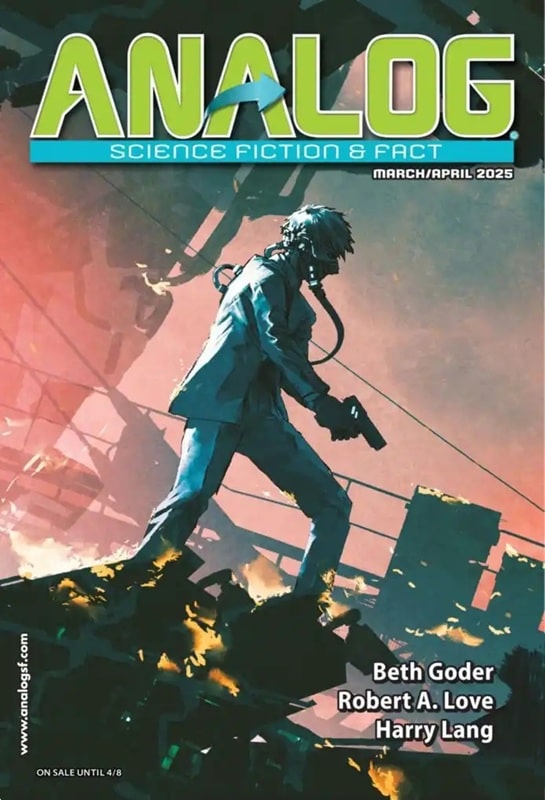
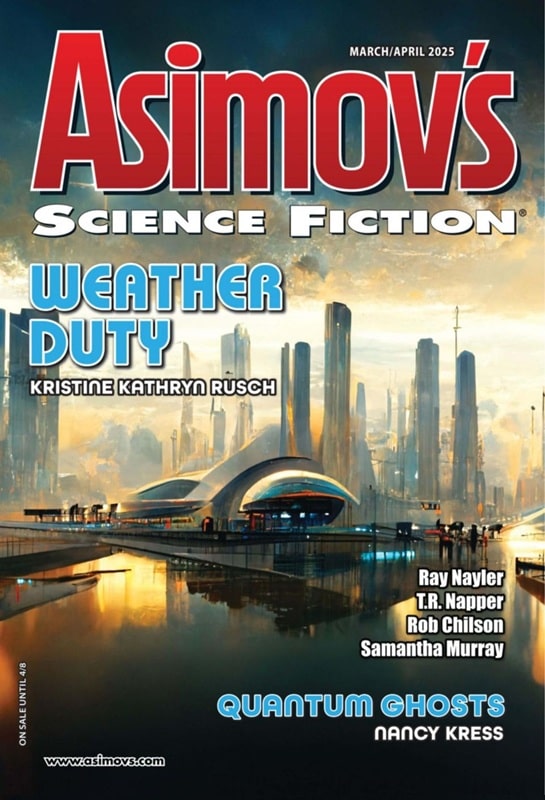
March-April 2025 issues of Analog Science Fiction & Fact
and Asimov’s Science Fiction. Cover art by Shutterstock
The big news this month is that all three print science fiction magazines, as well as the mystery magazines owned by Penny Press, have been sold to a new buyer, a consortium of fans who have have ambitions to maintain and grow all five. Here’s an excerpt from the announcement at Locus Online.
Alfred Hitchcock’s Mystery Magazine, Analog Science Fiction and Fact, Asimov’s Science Fiction, Ellery Queen Mystery Magazine, and The Magazine of Fantasy & Science Fiction have been acquired by Must Read Magazines, a division of a new publishing company, Must Read Books Publishing. All editorial staff from the magazines have been retained in the acquisitions… Must Read Magazines is financially backed by a small group of genre fiction fans. A major investor and board advisor is Michael Khandelwal, the founder of a writing nonprofit and Virginia’s Mars Con toastmaster.
Read all the details, including quotes from Asimov’s editor Sheila Williams, Analog editor Trevor Quachri, and F&SF publisher Gordon Van Gelder, at Locus Online.
Tentatively, I’m willing to believe this is Good News. It makes sense to have all five magazines under one roof, and the recent collapse of F&SF‘s publishing schedule (only one magazine shipped last year) seemed to auger its imminent demise. Though change is rarely good with magazines, and Dell Magazines/Penny Press has been a stalwart home for Asimov’s and Analog for over three decades, since 1992, keeping the magazines healthy and alive through decades of turmoil in the magazine business.
But there’s certainly an argument to be made that the magazines could benefit from a change, and sharing a single home. I’ve seen no announcement on when F&SF will resume publication, and I eagerly await news of the first issues of Asimov’s and Analog from the new publisher, due next week (April 8). Fingers crossed the transition will be smooth.
In the meantime, we’ve got the last Dell Magazine issues of Asimov’s Science Fiction and Analog Science Fiction & Fact in hand, and they’re just as enticing as usual, with contributions from Kristine Kathryn Rusch, Nancy Kress, Marissa Lingen, Ray Nayler, T.R. Napper, Rob Chilson, Robert A. Love, Beth Goder, Anthony Ha, and many more.
Victoria Silverwolf at Tangent Online enjoyed in the latest Asimov’s.
“Weather Duty” by Kristine Kathryn Rusch takes place in the domed city of Las Vegas in a near future where citizens are required to spend time on government committees, analogous to jury duty. The main character serves on the committee that controls the weather. She and a local celebrity are attacked by thugs with high-tech weapons, for reasons that only become clear at the end.
This novella is effective as crime/suspense fiction and as a portrait of a possible future. The speculative technology and the way the government committees work are quite convincing, both in their advantages and their limitations. The protagonist, a dancer and choreographer, is a plausible action heroine, able to deal with a crisis in a believable fashion while remaining a realistic character with whom one can empathize.
“The Hidden God” by T. R. Napper alternates sections of narrative describing unpleasant and often deadly fates facing various rich and famous characters with sections dealing with a philosopher interacting with a highly advanced artificial intelligence. It soon becomes obvious that the powerful AI is attacking people whom it believes are causing enough harm to others that they should be rendered powerless or even killed. It turns out that there is an unexpected connection between the AI and the philosopher. Often as vivid and visceral as any blood-soaked thriller, this novella also raises the age-old issue of whether it is acceptable to help many by harming few. The author doesn’t pretend to solve this ancient dilemma, but uses it to delve into the character of the philosopher.
The drug mentioned in the title of “The Demon of Metrazol” by Ray Nayler is a real one, formerly used to treat mental patients by inducing violent convulsions. In the 1930’s, a woman works at a mental hospital by photographing patients before, during, and after these grim treatments. The patients always display extreme terror when the drug is administered. The story’s ending offers hints as to why this occurs. This is a subtle and unnerving horror story, using disturbing facts of the past to create a growing sense of fear.
The narrator of “The Mystery of My Death” by Rob Chilson is a time traveler who discovers his own grave in the future. He ponders exactly when he might die, goes on a mission to correct an error made in the recent past, and makes a major change in his life. Despite the title and a premise that might seem morbid, this is an upbeat, optimistic story that emphasizes life rather than death.
In “Cryptid or Your Money Back” by Misha Lenau, people can buy kits that allow them to remove their human bodies and become mythical creatures, then switch back whenever they please. The narrator becomes a chupacabra, the so-called goatsucker of Latin American folklore. Reluctant to return to human form, or to socialize with other people who have changed their bodies in this way, the narrator eventually discovers what is really desired.
Read Victoria’s complete review here.
The new Analog is reviewed by the ever reliable Sam Tomaino at SFRevu. Here’s a sample.
The new short fiction begins with the novella, “Murder on the Eris Express” by Beth Goder. Who killed Captain Jeremy on the Eris Express when the sensors of Mo, the ship’s AI were shut off? Mo, who always wanted to be a detective, investigates. Fun story to begin the issue!
“Not Optimus Prime” by Lorraine Alden. Vera is using a QR59 quantum computer to find a large prime number. She actually succeeds at that and something more, but the presence of a man delivering helium puts her in peril. Exciting story.
“It Eats Metal” by Mark Ferguson. Our narrator and his friends investigate a swamp where two students and a dog had disappeared and woman’s legs had been severely injured. What do they find? Nice mystery.
“Those Other Replicator Manufacturers Are Ripping You Off” by Jon Lasser. Some guidelines on getting replicators for your space ship. Amusing.
“Concerning the Multiplicity of Children in Central Florida’s Suburbanized Wetlands” by Ichabod Cassius Kilroy. Mori is almost nine years old and her brother, Orion, is almost five. Each morning she sees ghosts of their possible futures, some good, some bad. Interesting.
“The Code of His Life” by Owen Leddy. Ava and her friend, Alejandro, are in the grey market drug-hacking business. He is offered a job for a big legit firm and takes it. But when he drops dead, Ava knows he was murdered. She investigates and finds a way to have justice. Good story!
“Heat Death” by Kate McLeod. Detective Lidia is called in by her old friend, Chloe, to investigate a man who died of heat in the middle of the Texas desert. What she finds out is tragic. Poignant tale.
The fiction concludes with the novella, “The Return of Tom Dillon” by Harry Lang. This is a follow-up to the novelette, “Hothouse Orchids” by Harry Lang in the January/February 2023. Detective Hector Kovack returns to investigate another murder connected to the group behind the previous one. Does it have a connection to the return of an old friend working on a political campaign? Some good old hard-boiled detective stuff here. I hope I see more.
Yes, there was a crime theme to most of the stories of this issue, I almost thought I was reading Ellery Queen’s Mystery Magazine!
Read Sam’s full review here.
Here’s all the details on the latest SF print mags.
[Click the images for bigger versions.]
 Analog Science Fiction & Science Fact, March-April 2025 contents
Analog Science Fiction & Science Fact
Analog Science Fiction & Science Fact, March-April 2025 contents
Analog Science Fiction & Science Fact
Editor Trevor Quachri gives us a tantalizing summary of the current issue online, as usual.
Normally, we think of the March/April issue as something of our “humor and hoaxes issue,” in keeping with the seasonal spirit of April Fool’s Day. This time, however, we’re focusing on another important day in April: Tax Day. Yes, the only things certain in life are death and taxes, and the bulk of our stories lie at the juncture where death and money meet: crime.
Our lead story from Beth Goder, “Murder on the Eris Express,” might evoke familiar images of a mustachioed Belgian on a train, but the parallels end at the title — I promise you’ve never seen a “detective” quite like this. And there are plenty more SF/crime pieces to accompany this one, including:
“The Return of Tom Dillon,” a sequel to Harry Lang’s excellent future noir, “Hothouse Orchids” [January/February 2023]; the opposite of a locked-room mystery, in “Heat Death,” by Kate MacLeod; the definition of a gambling problem, in John Markley’s “In the Hole”; and more.
Plus, of course, we have to include at least some lighter fare, such as “A Whole Generation” by Timons Esias and “Mr. Palomar Goes to Space” by Hayden Trenholm, just for starters, plus our fact article, “Reflections on Mirror Life,” by Robert A. Love — think biochemistry, not Star Trek — and all our regular columns, as well as maybe a surprise or two!
Here’s the full TOC.
Novellas
“Murder on The Eris Express,” Beth Goder
“The Return of Tom Dillon,” Harry Lang
Novelettes
“The Code of His Life,” Owen Leddy
“Heat Death,” Kate MacLeod
Short Stories
“Not Optimus Prime,” Lorraine Alden
“Ti Eats Metal,” Mark Ferguson
“To Reap, To Sow,” Lyndsey Croal
“The Emergency Contact,” Arendse Lund
“Those Other Replicator Manufacturers Are Ripping You Off,” Jon Lasser
“Track Eats Track,” Avi Burton
“Concerning the Multiplicity of Children in Central Florida’s Suburbanized Wetlands,” Ichabod Cassius Kilroy
“Palomar Goes to Space,” Hayden Trenholm
“Echo, Write to All,” Nate Givens
“The Timecop and the Timesocial-worker,” S.L. Harris
“If the Weather Holds,” Marissa Lingen
“Murder With Soft Words,” Mike Duncan
“In the Hole,” John Markley
Probability Zero
“A Whole Generation,” Timons Esaias
Flash Fiction
In Her Element, M.t. Reiten
Science Fact
Reflections On Mirror Life, Robert A. Love
Poetry
The Dark Matter Storm, Deborah L. Davitt
Precocious Child, Alexander Senko
Reader’s Departments
Guest Editorial: Seeking Scientific Common Ground, Even On Guns, Richard A. Lovett
In Times To Come
The Alternate View, John G. Cramer
The Reference Library, Rosemary Claire Smith
Brass Tacks
 Asimov’s Science Fiction, March-April 2025 contents
Asimov’s Science Fiction
Asimov’s Science Fiction, March-April 2025 contents
Asimov’s Science Fiction
Sheila Williams provides a handy summary of the latest issue of Asimov’s at the website.
Our March/April 2025 issue is bursting with fiction. We have three exciting novellas stuffed into our pages. Kristine Kathryn Rusch opens the issue with a thrilling story about “Weather Duty”; T.R. Napper brings us an intense tale about a rogue AI in “The Hidden God”; and Nancy Kress bookends the issue with Part 1 of a giant novella that exposes the terrifying consequences of coexistence with “Quantum Ghosts”!
Ray Nayler reveals the true horror behind “The Demon of Metrazol”; Rob Chilson attempts to resolve “The Mystery of My Death”; new author Anthony Ha gives us “A Brief History of the Afterlife”; new to Asimov’s author Samantha Murray spins the bittersweet tale of “My Heart a Streak of Light Across the Sky”; and new author Donald McCarthy shocks us with truths about “Unidentified Aerial Phenomenon.” Zohar Jacobs returns to our pages with a tense story about what it means to be “On the Night Shift,” and Misha Lenau makes good on the promise of “Cryptid or Your Money Back.”
Robert Silverberg’s Reflections explains “The Naming of Names”; James Patrick Kelly’s On the Net considers “Spaceships of the Mind”; and Norman Spinrad’s On Books muses about “Speculative Literature?” Plus we’ll have an array of poetry you’re sure to enjoy.
Here’s the complete Table of Contents.
Novellas
“Weather Duty” by Kristine Kathryn Rusch
“The Hidden God” by T.R. Napper
“Quantum Ghosts” (Part I) by Nancy Kress
Novelette
“On the Night Shift” by Zohar Jacobs
Short Stories
“My Heart a Streak of Light Across the Sky” by Samantha Murray
“Unidentified Aerial Phenomenon” by Donald McCarthy
“The Demon of Metrazol” by Ray Nayler
“The Mystery of My Death” by Rob Chilson
“A Brief History of the Afterlife” by Anthony Ha
“Cryptid or Your Money Back” by Misha Lenau
Poetry
Intergalactic Tanka by Anna Cates
After the Chemicals Decay by Claire McNerney
Now that I Have Found You by Robert Frazier
Learning Toy by Don Mark Baldridge
All the Space We Have Left by Marisca Pichette
Hourglass by Greg Schwartz
Departments
Editorial: Magnifique! Redux by Sheila Williams
Reflections: The Naming of Names by Robert Silverberg
On the Net: Spacecraft of the Mind by James Patrick Kelly
Next Issue
On Books by Norman Spinrad
Analog, Asimov’s Science Fiction and The Magazine of Fantasy & Science Fiction are available wherever magazines are sold, and at various online outlets. Buy single issues and subscriptions at the links below.
Asimov’s Science Fiction (208 pages, $8.99 per issue, one year sub $47.97 in the US) — edited by Sheila Williams
Analog Science Fiction and Fact (208 pages, $8.99 per issue, one year sub $47.97 in the US) — edited by Trevor Quachri
The Magazine of Fantasy & Science Fiction (256 pages, $10.99 per issue, one year sub $65.94 in the US) — edited by Sheree Renée Thomas
The March-April issues of Asimov’s and Analog were on sale until April 8. See our coverage of the January-February issues here, and all our recent magazine coverage here.
Women in SF&F Month: Kamilah Cole
Women in SF&F Month officially starts today with a guest post by Kamilah Cole! Her debut novel and the first book in her Divine Traitors trilogy, So Let Them Burn—which she described as being “about sisterhood, chosen ones, dragons, anti-imperialism, anti-colonialism, and the aftermath of war” in a post on Goodreads—was a National Indie bestseller for multiple weeks and a nominee for the Goodreads Choice Awards for Young Adult Fantasy. It was recently joined by the conclusion to the series, […]
The post Women in SF&F Month: Kamilah Cole first appeared on Fantasy Cafe.Teaser Tuesdays - Vexing the Grumpy Orc
"Almost done." The witch's smug superiority crawled under my skin. "Unless you prefer to keep glaring holes in my back?"
(page 1, Vexing the Grumpy Orc by Chloe Graves)
---------
Teaser Tuesdays is a weekly bookish meme, previously hosted by MizB of Should Be Reading. Anyone can play along! Just do the following: - Grab your current read - Open to a random page - Share two (2) “teaser” sentences from somewhere on that page BE CAREFUL NOT TO INCLUDE SPOILERS! (make sure that what you share doesn’t give too much away! You don’t want to ruin the book for others!) - Share the title & author, too, so that other TT participants can add the book to their TBR Lists if they like your teasers!
Book review: A Drop of Corruption (Shadow of the Leviathan #2) by Robert Jackson Bennett

ABOUT THE AUTHOR: Robert Jackson Bennett is a two-time award winner of the Shirley Jackson Award for Best Novel, an Edgar Award winner for Best Paperback Original, and is also the 2010 recipient of the Sydney J Bounds Award for Best Newcomer, and a Philip K Dick Award Citation of Excellence. City of Stairs was shortlisted for the Locus Award and the World Fantasy Award. City of Blades was a finalist for the 2015 World Fantasy, Locus, and British Fantasy Awards. His eighth novel, FOUNDRYSIDE, will be available in the US on 8/21 of 2018 and the UK on 8/23.
Publisher: Del Rey (April 1, 2025) Length: 458 Formats: audiobook, ebook, hardcover
Robert Jackson Bennett has done it again. A Drop of Corruption takes everything that made The Tainted Cup great (impossible murders, weird biology, razor-sharp wit) and somehow makes it even better. There’s a new impossible crime, more unsettling biology, and, most importantly, more Ana Dolabra - the world’s strangest mind.
This time around, Ana and her long-suffering assistant Dinios Kol are sent to the empire’s edges to investigate a treasury officer’s disappearance. And let me tell you - it’s a gruesome murder, because if there’s one thing Bennett knows how to do, it’s making sure every crime scene sticks in your brain. This one involves dismemberment, vanished body parts, and a killer who seems to walk through walls.
Ana solves the surface-level mystery in about five minutes, but the deeper they dig, the more tangled the case becomes. The stakes turn shockingly high. If they fail, the entire empire could collapse, and leave the world defenseless against the leviathans. No pressure. Someone out there is playing a game Ana isn’t used to losing, and Din finds himself torn between his duty as her “engraver” and his growing realization that being an investigator might not be the life he truly wants.
Now, for me the series works because we follow a brilliant and fascinating character (Ana) through the eyes of a much more bland one (Din). Din is to Ana what Watson was to Sherlock - a trusted assistant with some personality but not enough charisma to carry the series. A Drop of Corruption gives us glimpses into Ana’s past and hints at what she truly is. She’s still an enigma, but things get much clearer and much more exciting. Din, meanwhile, starts questioning his place in all of this. He signed up to be Ana’s eyes and ears to pay off his father’s debts, but as he gets drawn deeper into the empire’s ugly truths, he starts to wonder if he should be fighting to save it or choose a simpler and more profitable path.
The world-building continues to impress and remains one of the most inventive things I’ve ever read. The concept of Leviathans and the horrifying ways in which their blood transforms environment is cool. Then we have the Shroud - a living, organic space with peculiar properties. And the new characters fit right into this strange, unsettling world. Mala, for example, has an enhanced sense of smell (and more), which makes her an excellent investigator but also means she’s experiencing reality in ways that most people can’t understand.
Since Bennett doesn’t do one-note villains, the antagonist is ruthless, brilliant, and broken. Their backstory is a slow-burn tragedy that creeps up on you. If I had to nitpick, I’d say that the book is sometimes too detailed and repetitive in the middle. But honestly, when the writing is this good, why would I want to nitpick?
Ultimately, I’m satisfied, impressed, and desperately hoping we get another one in the series. Because if Bennett keeps building on this foundation, we might just be looking at one of the best fantasy mystery series of the decade.


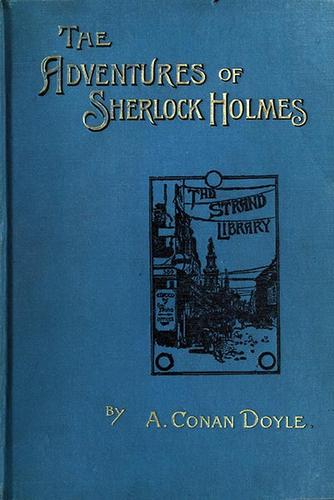
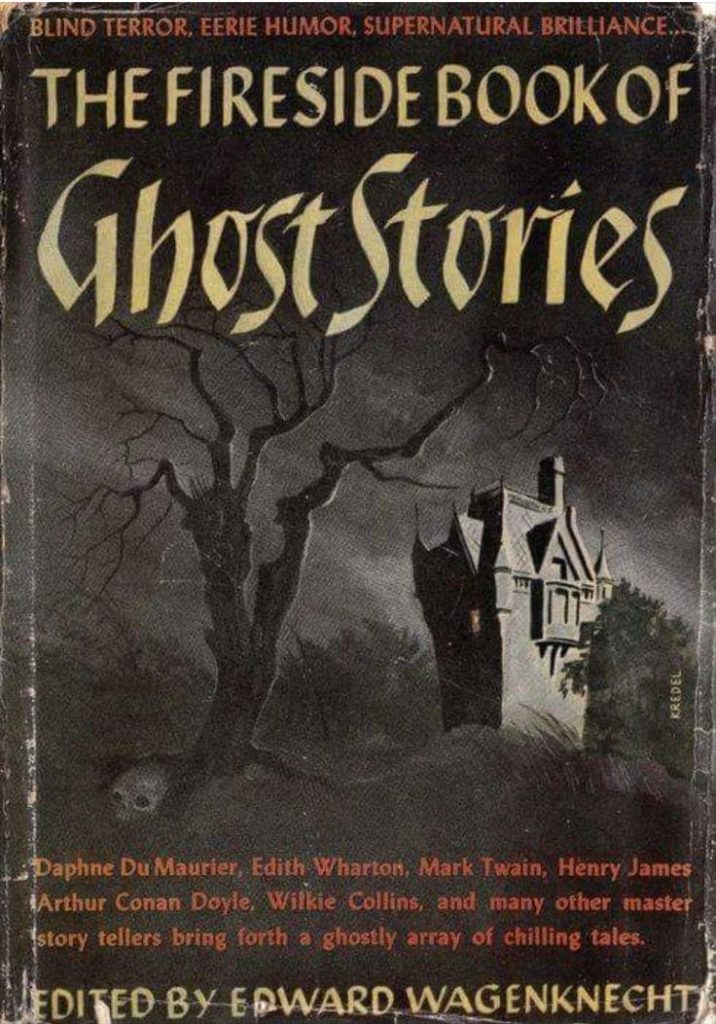

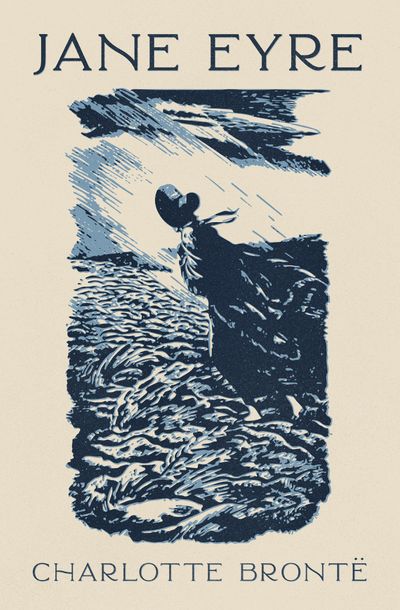



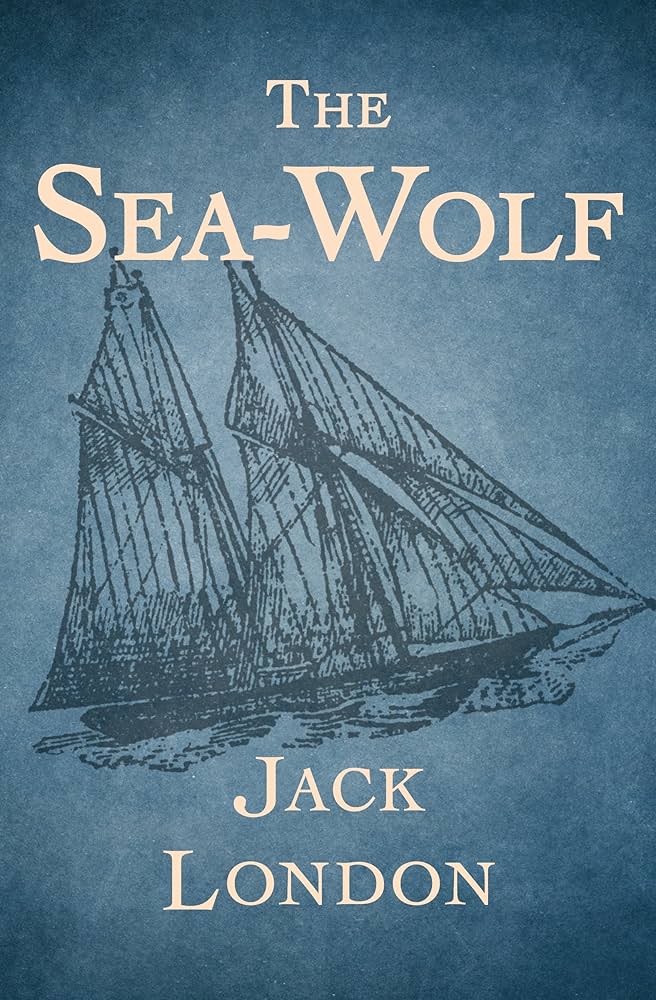

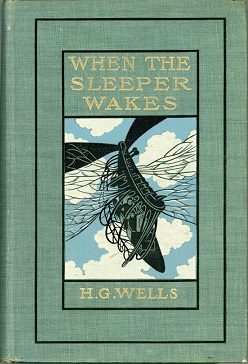


Recent comments